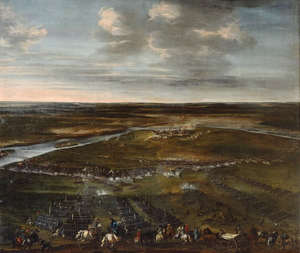納爾瓦戰役 (1700年)
外观
此條目需要擴充。 (2012年12月1日) |
此條目的引用需要清理,使其符合格式。 (2017年2月10日) |
| 纳尔瓦之役 | |||||||
|---|---|---|---|---|---|---|---|
| 大北方戰爭的一部分 | |||||||
 《1700年纳尔瓦之役》,由丹尼尔·斯图尔特绘制 | |||||||
| |||||||
| 参战方 | |||||||
|
|
| ||||||
| 指挥官与领导者 | |||||||
|
卡爾十二世[3] 卡爾·古斯塔夫·雷恩斯基爾德[3] 奧托·韋靈克[3] |
夏爾·德·克羅伊[3] 阿維托諾姆·戈洛文[3] 伊萬·特魯貝齊科伊[3] 亞當·韋德[3] 鮑里斯·舍列梅捷夫[3] 伊梅列季親王[3] | ||||||
| 兵力 | |||||||
|
納爾瓦兵營: 1,800人 297門火砲 援軍: 10,500人 37門加農砲[a] |
37,000人 195門火砲[b] | ||||||
| 伤亡与损失 | |||||||
|
667人戰死 1,247人負傷[c] |
超過9,000人戰死 20,000人被俘[d] | ||||||
|
註腳
| |||||||
纳尔瓦之役(俄语:Битва на Нарве,瑞典語:Slaget vid Narva,英語:Battle of Narva)发生于1700年11月30日,俄羅斯帝國入侵瑞典領土。最終瑞典国王卡爾十二世以一流的战术大败沙皇彼得大帝的大军。這場戰役是大北方战争的開端。
11月30日,37,000名俄军包围了仅由8,140名瑞典军(由卡尔十二世率领)防守的纳尔瓦,但中午,查理十二世的瑞典军与援兵突袭俄军,轻易地把慌张的俄军打败,加上俄军指挥多是外地人,使很多军团都不能合作,所以战役后,俄军失去了足足15,000人,而瑞典则只有667人阵亡。
參考資料
[编辑]- ^ Kerala J. Snyder (2002), p.137. [2016-11-30]. (原始内容存档于2022-03-22).
- ^ Magnus Stenbock Count and Spy. [2016-11-30]. (原始内容存档于2018-06-14).
- ^ 3.0 3.1 3.2 3.3 3.4 3.5 3.6 3.7 3.8 Jeremy Black (1996), p. 111
- ^ Christer Kuvaja (2008), p.139
- ^ Lars-Eric Höglund, Åke Sallnäs, Alexander Vespalov (2011). Great Northern War 1700 - 1721, II.
- ^ Generalstaben (1918-1919). Karl XII på slagfältet.
- ^ Tacitus.nu, Örjan Martinsson. Russian force.. [2016-11-30]. (原始内容存档于2018-08-31).
- ^ 8.0 8.1 8.2 8.3 Boris Grigorjev & Aleksandr Bespalov (2012). Kampen mot övermakten. Baltikums fall 1700-1710. pp. 38
- ^ 9.0 9.1 Ullgren (2008), p.57
- ^ Ericson (2003), p. 257
- ^ Cathal J. Nolan (2008). Wars of the Age of Louis XIV, 1650-1715. pp. 313
- ^ Hughes, Lindsey. Russia in the Age of Peter the Great. — New Haven: Yale University Press, 1998. pp. 30.
- ^ Olle Larsson, Stormaktens sista krig (2009) Lund, Historiska Media. pp. 99
